We recently reviewed the Neutral Asset Allocation (NAA) for the First Sentier Multi-Asset Real Return Fund; an exercise that is undertaken twice a year. This note summarises the key drivers of investment markets over the most recent six month period and outlines the changes made to the NAA following this most recent formal review.
For some time the world has been grappling with the fallout of the Covid-19 pandemic — the impact on society, on economic growth, inflation and mobility — but the outbreak of war in Ukraine in late February and the ongoing conflict has resulted in even greater insecurity and market instability. Since our last Neutral Asset Allocation (NAA) Review, we have been closely monitoring the tightening of fiscal policy measures by major central banks, rapidly rising inflation, continued supply-chain disruptions and, of course, the broader implications of the conflict in Ukraine.
Our return expectations for major asset classes have evolved and the Fund’s NAA has been amended accordingly and are summarised in the table below.
What exactly is the NAA review?
The first step in our investment process is to determine the economic outlook, both globally and for individual countries. Twice a year, we formally review existing assumptions and determine the likely long-term values for inflation, risk free rates, long-term bond yields, and earnings growth.
Using current valuations as a starting point, these determinations enable us to calculate expected returns for various asset types globally. In turn, this helps inform the most appropriate mix of investments (NAA) that have the highest likelihood of achieving the Fund’s long-term objectives.
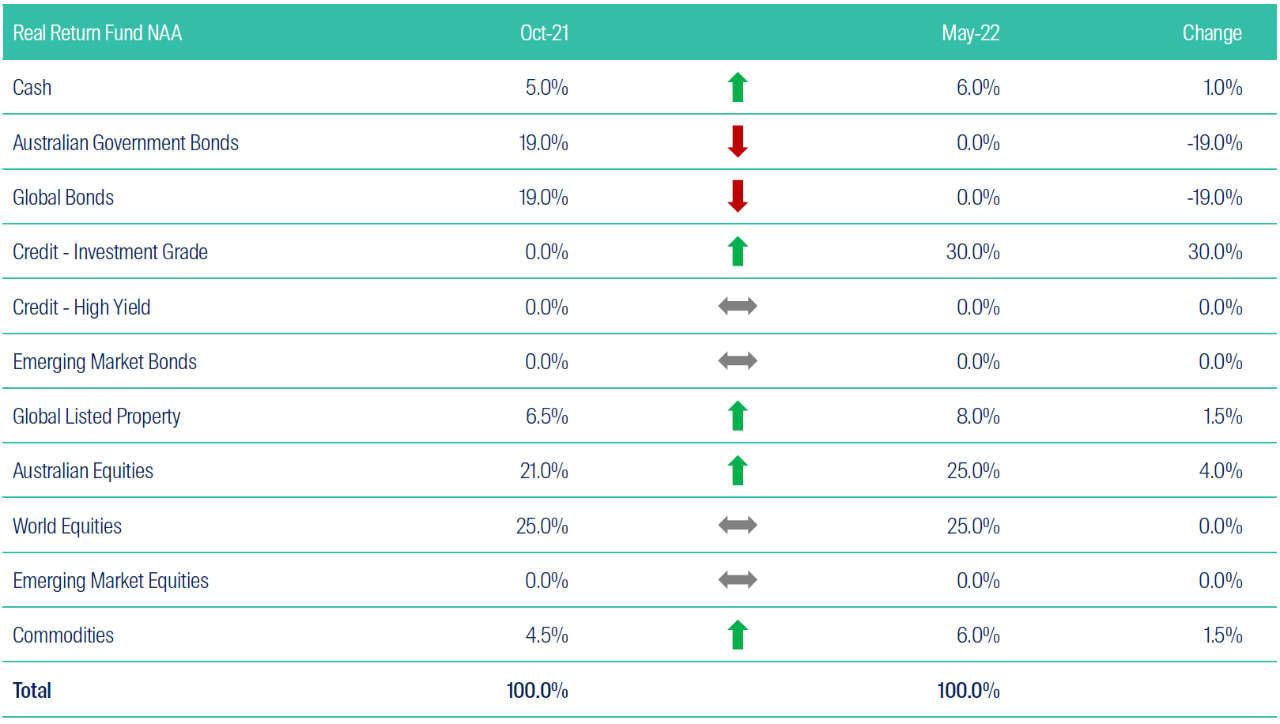
Source: First Sentier Investors as at 20 May 2022
How do we determine the right mix of NAA (beta) and DAA (alpha)?
Based on our assumptions for the economic climate, and our expected returns, we can determine the likelihood of meeting the portfolio’s objectives over the investment horizon. It is becoming increasingly likely that relying solely on the NAA in a constrained long only, unlevered environment will not be sufficient to meet the return objectives. This is where we use our DAA process, which takes shorter-term market dynamics into account and aims to deliver additional returns, as well as mitigate portfolio risks. By adding an uncorrelated return source (alpha) we can improve the likelihood of meeting the Fund’s investment objectives.
The combination of NAA and DAA requires the consideration of the current allocations; as the extent to which active management may be used is managed through the portfolio’s risk budget to avoid unwanted additional risks. We consider both the tracking error (as well as other risk metrics) and the expected return, in assessing the portfolio’s ability to meet its investment objective. The ability to add scalable alpha to portfolios provides flexibility to deliver on the investment objective; even in a lower return environment.
In the current low return environment it is critical to have the flexibility to blend beta and alpha to deliver a real return of 4.5% pa above inflation over rolling five year periods before fees and taxes. We believe our investment process and philosophy provides our clients the highest possibility of obtaining a real return and expect the DAA process to be of paramount importance given the current outlook for major asset classes.
Key points
The setting of the economic climate involves deciding on where we think the global economy is moving, and then for each country we determine the likely long-term values for inflation, risk free rates, long-term bond yields and earnings growth. By taking current valuations as a starting point, this allows us to determine expected returns for global assets from this point forward.
- Overall, meaningful changes to the Neutral Asset Allocation have been made. Our economic climate assumptions continue to evolve in response to the ongoing recovery from the Covid-19 crisis, against the backdrop of high inflation and rising interest rates. Additionally, the war in Ukraine has escalated geopolitical tensions, providing additional uncertainty.
- In a rising interest rate environment, both fixed income and equity returns have experienced an uptick in volatility. Our analysis suggests that most asset classes have slightly higher expected returns, driven by higher earnings and inflation. In 2021, we increased our inflation assumptions across all markets and anticipated higher cash rates and long-term bond yields. We have further adjusted several countries’ inflation, and cash rates, higher again in 2022.
- As Covid-19 vaccination rates increased and lockdown measures eased, corporate earnings picked up to more normalised levels. Subsequent inflation readings were persistently higher than expected.
- In the current environment, portfolio positioning has focused on the balance between equities and bonds with a reduction to the portfolio’s sensitivity to rising interest rates. We have decreased the allocation to Australian and Global bonds and have re-allocated a large portion of the sale proceeds into investment grade credit. Our assumptions have indicated a strong preference for a duration hedged exposure.
- The remainder has been allocated between Global Listed Property, Australian Equities and Commodities.
- Global property has seen a further increase in allocation
- in this review, which will allow the Fund to participate more meaningfully in the recovery as global mobility restrictions ease further.
- We expect that rising rates will put pressure on equity valuations so to provide diversification, all of the Fund’s global equity exposure is currently unhedged. This should provide a buffer in the scenario where the Australian dollar weakens.
- The commodities allocation has increased, from 4.5% to 6.0%. For diversification, this exposure has expanded to include precious metals, industrial metals, and agricultural commodities. These exposures provide inflation linkages to the ongoing supply constraint issues in the near term, and sustained demand pressures from a growing global economy over the longer term.
- While market conditions remain uncertain, a pick-up in volatility can present opportunities that can be exploited through the DAA process.
- The Fund continues to strive for consistent returns above inflation, while aiming to minimise drawdowns and preserve investor capital.
- As a highly experienced team, the Multi-Asset Solutions team will continue to implement the Fund’s established and methodical Neutral Asset Allocation (NAA) investment process and then adjust positioning through the Dynamic Asset Allocation (DAA) process as opportunities arise.
New disruptions to the economic recovery
After two long years of lockdowns, multiple Covid-19 variants, overwhelmed hospitals, and general uncertainty about life as we once knew it, the rollout of effective vaccines and an increase in herd immunity was finally pointing toward a return to ‘normal’. Many people that had lost work during the lockdowns have returned to work, as consumer sentiment and economic activity were beginning to recover. Demand for labour as industries have re-opened has been so substantial that there is now a shortage of workers in some sectors with some people not returning to the jobs they held before, or at least not for the same wages and conditions. Alongside the supply-chain disruptions, this increase in wages is further adding to the concerns of persistently high inflation. Overall, many economies have seen this significant increase in inflation; after a long period of ultra-loose fiscal and monetary policy measures, there will be a lot of focus on how policymakers wind these back.
On top of these pressures, Russia’s invasion of Ukraine has prompted significant uncertainty throughout Europe, and placed additional strain on energy prices. Pandemic-related supply-chain bottlenecks are lingering, particularly as China’s ‘zero-Covid’ policy has weighed on economic activity in the country as the Omicron variant spread. Harsh lockdown measures are still a usable lever for Chinese authorities, with large cities like Shanghai — as well as several key manufacturing hubs — shutting down temporarily. Industrial production and exports have been hampered, adversely affecting supply chains globally.
While the economic recovery from the Covid-19 pandemic was progressing, this unanticipated development has clouded the outlook and has sent consumer sentiment in key regions moving lower again. Unsurprisingly, given the current state of the world, the International Monetary Fund’s (IMF) growth projections made in January 2022 downgraded in April. According to the IMF, global growth is now projected to slow to 3.6% in 2022, compared to a previous forecast of 4.4%. In particular, both Ukraine and Russia are expected to experience sizable economic contractions over the year. The destruction of infrastructure, the displacement of people and the loss of life seem likely to impact Ukraine for an extended period. Meanwhile, Russia has started to feel the effects of economic sanctions, the severance of trade ties and diminishment of confidence1.
Chart 1: IMF Economic Growth Projections
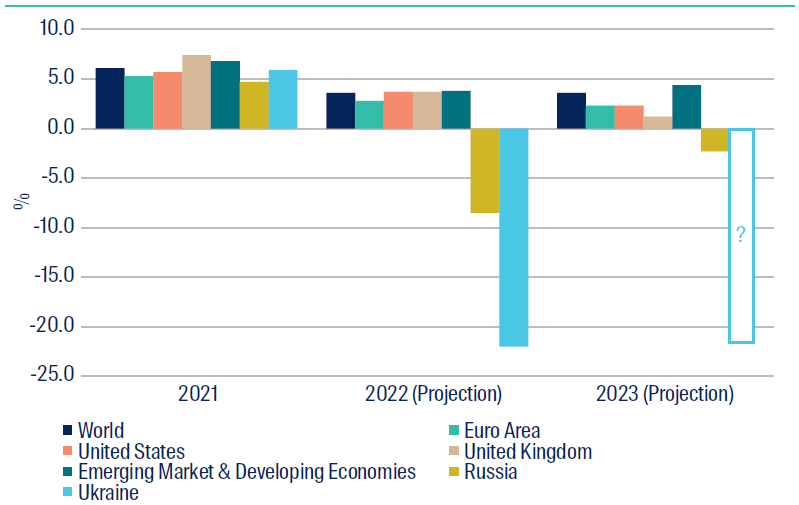
Source: International Monetary Fund April 2022 World Economic Outlook
Ukraine war
On 24 February 2022, news broke that Russian forces had invaded Ukraine. The impact of the conflict is not bound by the borders of Ukraine; while Ukraine is most directly impacted, the negative effects have spread throughout Europe and, to some extent, the rest of the world. Millions of Ukrainians have been displaced from their homes, with many ending up in neighbouring eastern European nations such as Poland, Romania, Moldova and Hungary. This will only add to the growing pressures these regions are already facing. As Russia is a major exporter of oil and gas, the geopolitical tensions have caused a surge in commodity prices. While this is not the only driver of the recent uptick in inflationary pressure, it has certainly exacerbated existing pricing pressures. The reliance on Russian commodities has been a particular focal point after Germany decided to halt the Nordstream 2 gas pipeline project, designed to transport Russian gas directly to Germany. More broadly, EU members are discussing reducing reliance on Russian commodities. While the outcome remains to be seen, there has already been some confrontation; Russia has halted gas supplies to Poland and Bulgaria until they pay in rubles. We expect that there will be a myriad of additional risks from the conflict across financial markets and market function, inside and out of Russia.
Inflation
While most of the rhetoric from policymakers in 2021 tried to soothe markets with the ‘transitory’ inflation story, each subsequent inflation reading has continued to suggest otherwise. As illustrated in Chart 2, inflation across most major markets has been on the rise. Finally, the tune has changed and central bankers have started to consider options to combat the surging costs of living. In the United States, the annual inflation rate accelerated to 8.5% in March2, the highest in more than 40 years. Inflation moderated only slightly in April, to an annual rate of 8.3%. The conflict in Ukraine, in particular, has pushed crude oil prices upward; as fuel oil prices rose more than 70% in February alone. Food prices have also risen by 8.8% on an annual basis, the most since May 1981. Some forecasters expect March to represent a peak in inflation, but with the war in Ukraine unlikely to end soon, prices could remain volatile for some time. Similarly, according to Eurostat, the annual inflation reading for the Euro Area surged to an all-time high of 7.4% in both March and April. Considering the current environment, this was in line with expectations. The current CPI rate is more than three times the European Central Bank’s (ECB) 2% target. The sanctions imposed on Russia are continuing to exert upward pressure on fuel and natural gas prices in the region; according to the IMF’s April 2022 world economic outlook, elevated inflation is expected to persist for a while to come.
Chart 2: Inflation rates of major economies
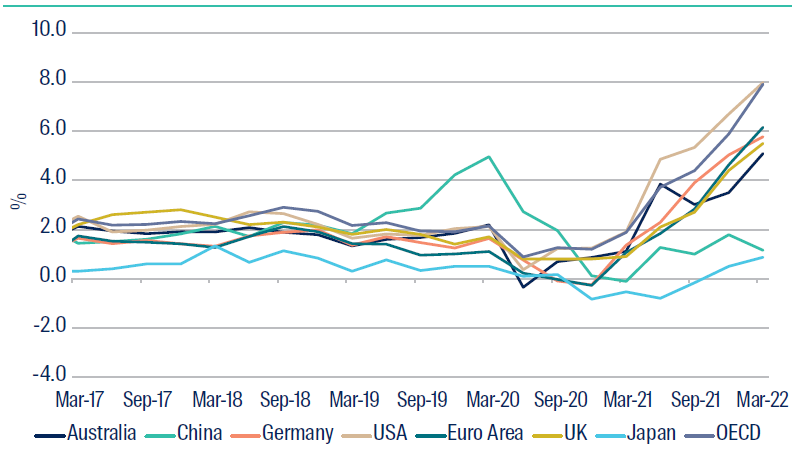
Source: OECD as at 11 May 2022. Annual inflation, quarterly, for the period 31 March 2017 to 31 March 2022
‘Licence to Hike’ - Policy tightening begins
In response to the upward movement in inflation, some central banks have started tightening monetary policy settings. Chart 3 below captures the number of interest rate hikes expected across the Eurozone and in the US, against the implied policy rate. The Bank of England was the first key bank to move, raising rates at its December 2021 meeting. Base rates were increased again in February and March, and again in early May. In the US, the Federal Reserve Bank (the ‘Fed’) increased the Federal Funds Rate by 0.25 percentage points to between 0.25% and 0.50% in March 2022, and by a further 0.50 percentage points in May. During the press conference in May, policymakers advised that further increases will occur if warranted, and at the March meeting there was a median of seven increases over 2022. With two hikes already implemented, Chart 3 below from Bloomberg’s World Interest Rate Probability function shows the expectations for another five hikes to come this calendar year. In Europe, the ECB President confirmed the tapering of the Pandemic Emergency Purchase Programme would finish in June, with the asset purchase programme to conclude in the third quarter of 2022. Subsequently an interest rate hike might be required if inflation remains elevated. While taming inflation is an important objective, there will likely be other implications of these policy changes. The Covid-19 pandemic led to a substantial increase in debt levels around the world3. With inflation already sitting at persistently high levels, the hiking of interest rates will place additional strains on budgets. As fiscal consolidation plays out, public budgets will need to balance the needs for social and other notable expenditures, such as defence. Without a successful transition from the elongated period of loose fiscal policy measures, confidence could further erode. Such sentiment could prompt capital outflows, particularly from emerging markets and encourage a debt crisis. Additionally, if advanced economies were to become more aggressive with their monetary policy adjustments, this could drive a further correction of asset prices.
Chart 3: Number of interest rate hikes priced in
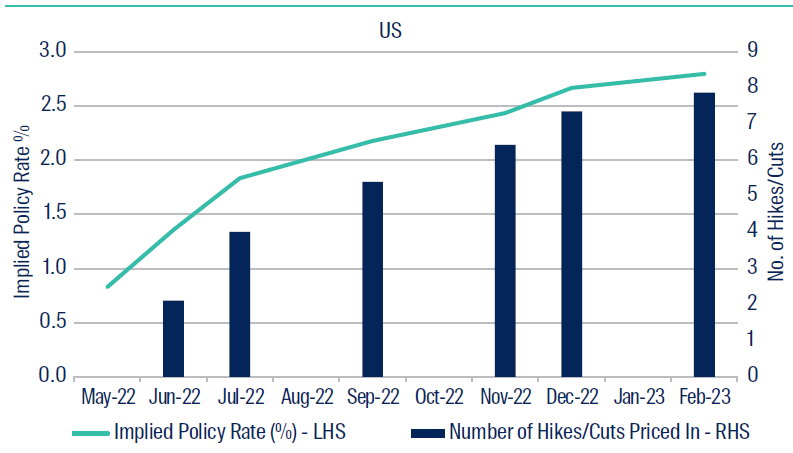
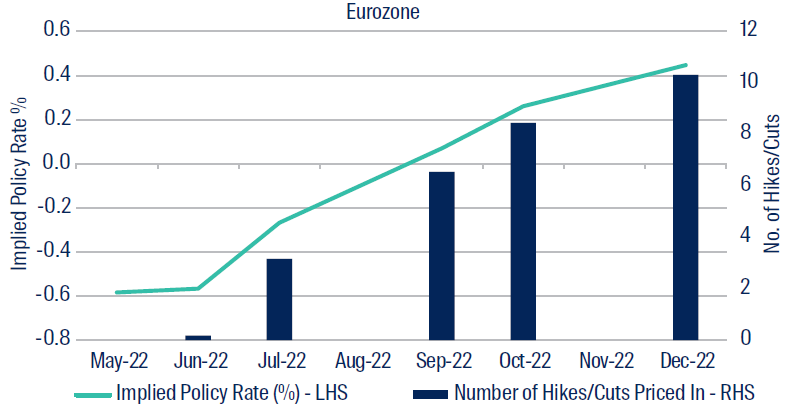
Source: Bloomberg World Interest Rate Probability as at 23 May 2022
Bonds, credit and equities
After several years of ultra-low interest rates and bond yields, the rising rate environment has already proved detrimental to fixed income returns. These unfavourable returns are not necessarily surprising; interest rates had been sitting close to zero for quite some time and always seemed likely to rise at some point. In the first four months of 2022, 10-year US Treasury yields rose 1.42%, to 2.93%. Over the same period, German 10-year bund yields rose 1.11%. This was a particularly notable move given bund yields had spent 30 months in negative territory, before rising back above zero at the end of January. As illustrated in Chart 4, government bond yields have risen significantly, after many years of trending downward. Due to the relationship between bond yields and interest rates, yields could continue to rise in the current environment where central banks appear committed to dampening inflation through higher interest rates. In turn, this could exert pressure on fixed income returns. Accordingly, and following the recent NAA review, the Fund currently has zero exposure to sovereign bond markets.
Chart 4: Change in benchmark 10-year government bond yields over 2022
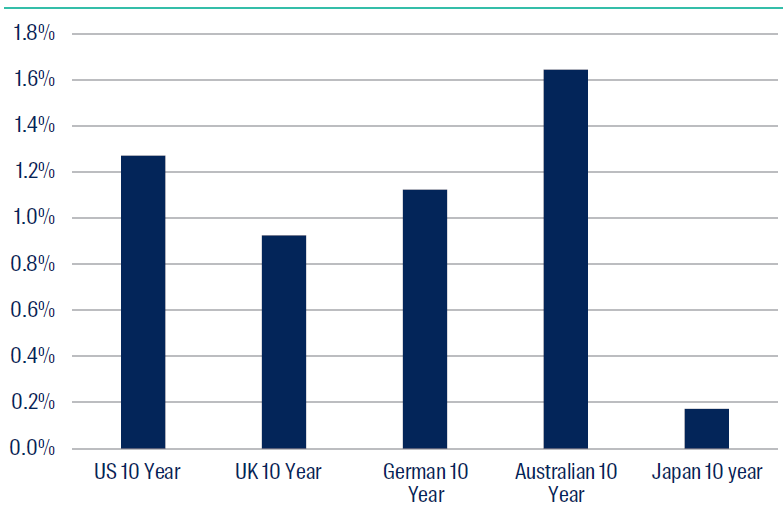
Source: Bloomberg as at 20 May 2022, period 31 December 2021 to 20 May 2022
Considering this environment, as part of our NAA review, we have re-allocated a significant portion of this exposure toward duration hedged investment grade credit. While the prospect of interest rate hikes is typically unwelcomed by credit investors as it increases the cost of debt, the interest rate sensitivity is being removed via the duration hedge. The perceived risk associated with central bank policy changes has prompted a widening of spreads. We had previously exited our credit allocation in April 2021 due to spread compression. As illustrated in Chart 5, the spread on the Bloomberg Global Aggregate Corporate Index — a typical representation of the global investment grade credit market — has increased by a sizeable 60 basis points over the calendar year to 20 May 2022.
Chart 5: Investment grade credit spreads over 2022
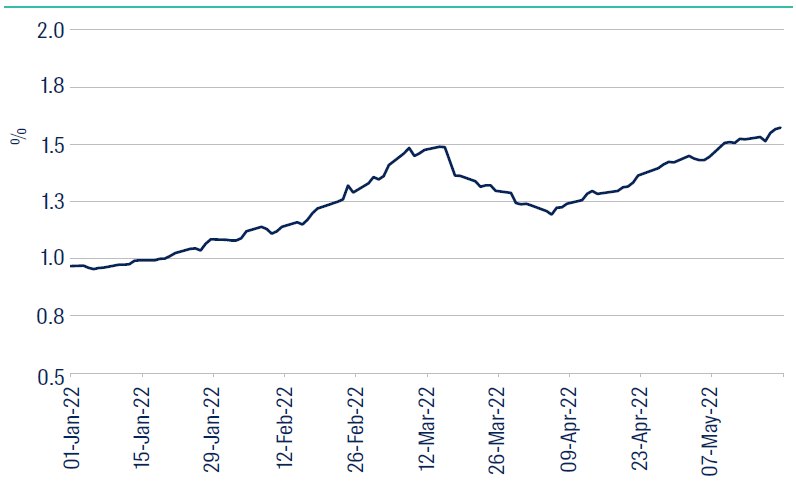
Source: Bloomberg Global Aggregate Corporate Index as at 20 May 2022, period 31 December 2019 to 20 May 2022
The calendar year to date has also been unkind to equity markets. This is partly due to the Ukraine war, rising interest rates, and high inflation that is creating a volatile environment for company valuations. The technology sector, particularly in the US, has delivered lacklustre returns over the past few months, followed by a particularly bad earnings season. Major global indices have experienced declines in the calendar year to date, with the tech-heavy US NASDAQ Index being the worst performer. Supply-chain disruptions, rising borrowing costs, as well as the lingering effects of the Covid-19 pandemic are likely to present ongoing challenges for equities.
Chart 6: Global equity market returns over 2022
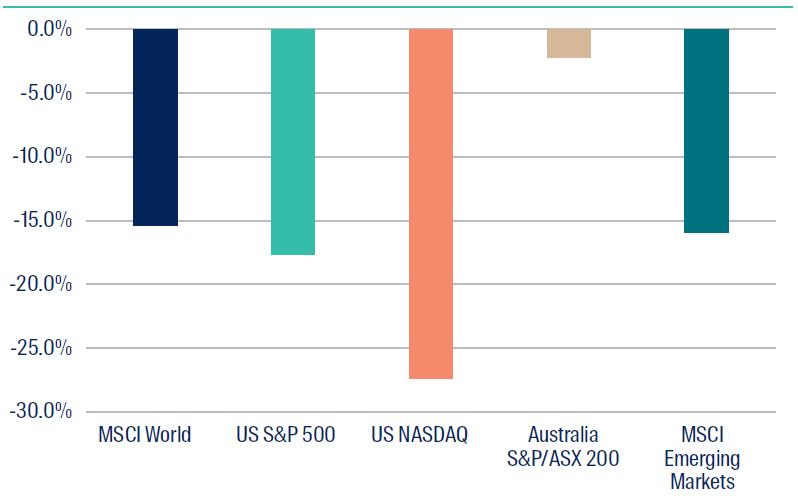
Source: Bloomberg as at 20 May 2022, period 31 December 2021 to 20 May 2022
Outlook
Having seen a sharp increase in volatility in the year to date, our outlook for financial markets remains cautious. Showing no signs of easing, the war in Ukraine continues to erode investor sentiment and is putting pressure on energy prices, exacerbating the rising costs of living. The global economy remains relatively resilient, although the Ukraine war is expected to slow the rate of growth. Global corporate earnings have been stronger than expected, but the removal of the fiscal and monetary tailwinds will reveal whether deeper issues have been masked. Labour markets have improved markedly, while the rising cost of living is placing additional pressure on wage inflation.
As other economic indicators continue to improve, central bank officials and monetary policy settings are in sharp focus, as policymakers consider how to best combat the persistently high inflation levels lingering across most major economies. Multiple interest rate hikes are anticipated across most major markets before the end of the year. In the US, for example, the market has priced in the likelihood of 0.50 percentage point increases in the Federal Funds Rate at each of the Fed’s next two or three meetings. In Europe, while the ECB has yet to imply an interest rate hike in the near term, the ongoing conflict in Ukraine and the associated price pressures have prompted investors to price in the probability of as many as four interest rate hikes in the remainder of 2022.
While the focus in Europe is highly revolved around the war in Ukraine, Covid-19 outbreaks continue to wreak havoc in China. The spread of the virus appeared to be under control for much of the past two years, but authorities now appear to be struggling under their ‘zero-Covid’ policy. Market sentiment has deteriorated after Shanghai spent all of April in lockdown. In fact, it appears China’s official 5.5% GDP growth target for 2022 may be difficult to achieve given subdued economic activity levels.
Bond yields continue to rise, although longer-term expectations remain within historically low ranges. A key risk is that a stagflation regime persists after the current supply-chain issues have been resolved through the entirety of 2022 and beyond. The rising yield environment continues to drive some caution among investors and is exerting downward pressure on equity valuations. Although corporate balance sheets remain solid and there is still an enormous level of pent-up demand in economies following lockdowns, investors are wondering whether this will be sufficient to support current valuations. We have adopted a cautious approach and began reducing the equity weight in our portfolios in January 2022, having previously introduced protection in October 2021 in recognition of these broad-based risks. With rates still close to all-time lows and with persistently high inflation, the risks are to the upside in interest rates. Thankfully, the flexibility of our objective-based strategies allows us to mitigate these risks, for example, the most material change made in this review is to take advantage of the repricing in fixed income markets to deliver additional yield through an allocation to investment grade credit, without increasing duration in the portfolio. We will continue to rebalance the portfolio as opportunities present themselves over the coming months, balancing both risk and return outcomes.
1 International Monetary Fund – April 2022 World Economic Outlook
2 US Bureau of Labor Statistics
3 International Monetary Fund - April 2022 World Economic Outlook
Important Information
This material has been prepared and issued by First Sentier Investors (Australia) IM Ltd (ABN 89 114 194 311, AFSL 289017) (FSI AIM), which forms part of First Sentier Investors, a global asset management business. First Sentier Investors is ultimately owned by Mitsubishi UFJ Financial Group, Inc (MUFG), a global financial group. A copy of the Financial Services Guide for FSI AIM is available from First Sentier Investors on its website.
This material is directed at persons who are ‘wholesale clients’ (as defined under the Corporations Act 2001 (Cth) (Corporations Act)) and has not been prepared for and is not intended for persons who are ‘retail clients’ (as defined under the Corporations Act). This material contains general information only. It is not intended to provide you with financial product advice and does not take into account your objectives, financial situation or needs. Before making an investment decision you should consider, with a financial advisor, whether this information is appropriate in light of your investment needs, objectives and financial situation.
The product disclosure statement (PDS) or Information Memorandum (IM) (as applicable) for the First Sentier Multi-Asset Real Return Fund, ARSN 161 207 165 (Fund) issued by Colonial First State Investments Limited (ABN 98 002 348 352, AFSL 232468) (CFSIL), should be considered before deciding whether to acquire or hold units in the Fund(s). The PDS or IM are available from First Sentier Investors.
MUFG, FSI AIM, their respective affiliates and any service provider to the Fund do not guarantee the performance of the Fund or the repayment of capital by the Fund. Investments in the Fund are not deposits or other liabilities of MUFG, FSI AIM, their respective affiliates or any service providers to the Fund and investment-type products are subject to investment risk including loss of income and capital invested.
Any opinions expressed in this material are the opinions of the individual author at the time of publication only and are subject to change without notice. Such opinions: (i) are not a recommendation to hold, purchase or sell a particular financial product; (ii) may not include all of the information needed to make an investment decision in relation to such a financial product; and (iii) may substantially differ from other individual authors within First Sentier Investors.
To the extent permitted by law, no liability is accepted by MUFG, FSI AIM nor their affiliates for any loss or damage as a result of any reliance on this material. This material contains, or is based upon, information that FSI AIM believes to be accurate and reliable, however neither MUFG, FSI AIM nor their respective affiliates offer any warranty that it contains no factual errors. No part of this material may be reproduced or transmitted in any form or by any means without the prior written consent of FSI AIM.
Any performance information has been calculated using exit prices after taking into account all ongoing fees and assuming reinvestment of distributions. No allowance has been made for taxation. Past performance is not indicative of future performance.
Copyright © First Sentier Investors
All rights reserved.
Get the right experience for you
Your location :  Australia
Australia
Australia & NZ
-
 Australia
Australia -
 New Zealand
New Zealand
Asia
-
 Hong Kong (English)
Hong Kong (English) -
 Hong Kong (Chinese)
Hong Kong (Chinese) -
 Singapore
Singapore -
 Japan
Japan



























 United Kingdom
United Kingdom 